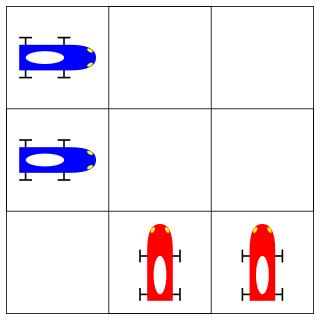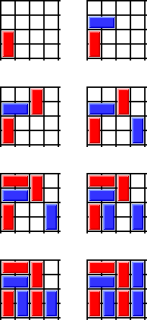Nim is a mathematical game of strategy in which two players take turns removing objects from distinct heaps or piles. On each turn, a player must remove at least one object, and may remove any number of objects provided they all come from the same heap/pile. Depending on the version being played, the goal of the game is either to avoid taking the last object, or to take the last object.
In combinatorial game theory, an impartial game is a game in which the allowable moves depend only on the position and not on which of the two players is currently moving, and where the payoffs are symmetric. In other words, the only difference between player 1 and player 2 is that player 1 goes first. The game is played until a terminal position is reached. A terminal position is one from which no moves are possible. Then one of the players is declared the winner and the other the loser. Furthermore, impartial games are played with perfect information and no chance moves, meaning all information about the game and operations for both players are visible to both players.
In mathematics, the nimbers, also called Grundy numbers, are introduced in combinatorial game theory, where they are defined as the values of heaps in the game Nim. The nimbers are the ordinal numbers endowed with nimber addition and nimber multiplication, which are distinct from ordinal addition and ordinal multiplication.

On Numbers and Games is a mathematics book by John Horton Conway first published in 1976. The book is written by a pre-eminent mathematician, and is directed at other mathematicians. The material is, however, developed in a playful and unpretentious manner and many chapters are accessible to non-mathematicians. Martin Gardner discussed the book at length, particularly Conway's construction of surreal numbers, in his Mathematical Games column in Scientific American in September 1976.
Misere, misère, bettel, betl, beddl or bettler is a bid in various card games, and the player who bids misere undertakes to win no tricks or as few as possible, usually at no trump, in the round to be played. This does not allow sufficient variety to constitute a game in its own right, but it is the basis of such trick-avoidance games as Hearts, and provides an optional contract for most games involving an auction.

Combinatorial game theory (CGT) is a branch of mathematics and theoretical computer science that typically studies sequential games with perfect information. Study has been largely confined to two-player games that have a position in which the players take turns changing in defined ways or moves to achieve a defined winning condition. CGT has not traditionally studied games of chance or those that use imperfect or incomplete information, favoring games that offer perfect information in which the state of the game and the set of available moves is always known by both players. However, as mathematical techniques advance, the types of game that can be mathematically analyzed expands, thus the boundaries of the field are ever changing. Scholars will generally define what they mean by a "game" at the beginning of a paper, and these definitions often vary as they are specific to the game being analyzed and are not meant to represent the entire scope of the field.
In combinatorial game theory, the zero game is the game where neither player has any legal options. Therefore, under the normal play convention, the first player automatically loses, and it is a second-player win. The zero game has a Sprague–Grundy value of zero. The combinatorial notation of the zero game is: { | }.

Elwyn Ralph Berlekamp was an American mathematician known for his work in computer science, coding theory and combinatorial game theory. He was a professor emeritus of mathematics and EECS at the University of California, Berkeley.
Col is a pencil and paper game, specifically a map-coloring game, involving the shading of areas in a line drawing according to the rules of Graph coloring. With each move, the graph must remain proper, and a player who cannot make a legal move loses. The game was described and analysed by John Conway, who attributed it to Colin Vout, in On Numbers and Games.

Hackenbush is a two-player game invented by mathematician John Horton Conway. It may be played on any configuration of colored line segments connected to one another by their endpoints and to a "ground" line.
In mathematics, the mex of a subset of a well-ordered set is the smallest value from the whole set that does not belong to the subset. That is, it is the minimum value of the complement set. The name "mex" is shorthand for "minimum excluded" value.

Dodgem is a simple abstract strategy game invented by Colin Vout in 1972 while he was a mathematics student at the University of Cambridge as described in the book Winning Ways. It is played on an n×n board with n-1 cars for each player—two cars each on a 3×3 board is enough for an interesting game, but larger sizes are also possible.
Eric Lengyel is a computer scientist specializing in game engine development and computer graphics. He holds a Ph.D. in Computer Science from the University of California, Davis and a master's degree in Mathematics from Virginia Tech.
Grundy's game is a two-player mathematical game of strategy. The starting configuration is a single heap of objects, and the two players take turn splitting a single heap into two heaps of different sizes. The game ends when only heaps of size two and smaller remain, none of which can be split unequally. The game is usually played as a normal play game, which means that the last person who can make an allowed move wins.
Kayles is a simple impartial game in combinatorial game theory. Using the notation of octal games, Kayles is denoted 0.77.
The octal games are a class of two-player games that involve removing tokens from heaps of tokens. They have been studied in combinatorial game theory as a generalization of Nim, Kayles, and similar games.

Cram is a mathematical game played on a sheet of graph paper. It is the impartial version of Domineering and the only difference in the rules is that each player may place their dominoes in either orientation, but it results in a very different game. It has been called by many names, including "plugg" by Geoffrey Mott-Smith, and "dots-and-pairs." Cram was popularized by Martin Gardner in Scientific American.
In the mathematical theory of games, genus theory in impartial games is a theory by which some games played under the misère play convention can be analysed, to predict the outcome class of games.
In combinatorial game theory, and particularly in the theory of impartial games in misère play, an indistinguishability quotient is a commutative monoid that generalizes and localizes the Sprague–Grundy theorem for a specific game's rule set.
In mathematics, tiny and miny are operators that yield infinitesimal values when applied to numbers in combinatorial game theory. Given a positive number G, tiny G is equal to {0||0|-G} for any game G, whereas miny G is tiny G's negative, or {G|0||0}.